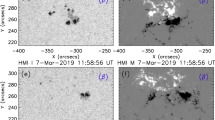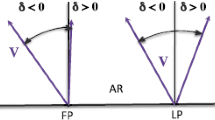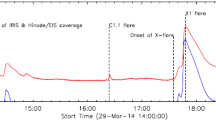Abstract
We present observations of hot arcades made with the Mg xii spectroheliograph onboard the CORONAS-F mission, which provides monochromatic images of hot plasma in the Mg xii 8.42 Å resonance line. The arcades were observed to form above the polarity inversion line between active regions NOAA 09847 and 09848 at four successive episodes: at 09:18, 14:13, and 22:28 UT on 28 February 2002, and at 00:40 UT on 1 March 2002. The evolution of the arcades can be described as: a) a small flare (precursor) appeared near the edge of the still invisible arcade, b) the arcade brightened in a wave-like manner – closer loops brightened earlier, and c) the arcade intensity gradually decreased in \({\approx}\,1~\mbox{h}\). The estimated wave speed was \({\approx}\,700~\mbox{km}\,\mbox{s}^{-1}\), and the distance between the hot loops was \({\approx}\,50~\mbox{Mm}\). The arcades formed without visible changes in their magnetic structure. The arcades were probably heated up by the instabilities of the current sheet above the arcade, which were caused by a magnetohydrodynamic wave excited by the precursor.









Similar content being viewed by others
References
Archontis, V., Hood, A.W., Tsinganos, K.: 2014, Recurrent explosive eruptions and the “sigmoid-to-arcade” transformation in the Sun driven by dynamical magnetic flux emergence. Astrophys. J. Lett. 786, L21. DOI . ADS .
Artemyev, A., Zimovets, I.: 2012, Stability of current sheets in the solar corona. Solar Phys. 277, 283. DOI . ADS .
Benz, A.O.: 2008, Flare observations. Living Rev. Solar Phys. 5(1). DOI . http://www.livingreviews.org/lrsp-2008-1 .
Bogachev, S.A., Somov, B.V., Kosugi, T., Sakao, T.: 2005, The motions of the hard X-ray sources in solar flares: Images and statistics. Astrophys. J. 630, 561. DOI . ADS .
Bradshaw, S.J., Cargill, P.J.: 2010, The cooling of coronal plasmas. III. Enthalpy transfer as a mechanism for energy loss. Astrophys. J. 717, 163. DOI . ADS .
Carmichael, H.: 1964, A process for flares. In: Ness, W.N. (ed.) AAS-NASA Symposium on the Physics of Solar Flares, NASA SP-50, 451. ADS .
Culhane, J.L., Phillips, A.T., Inda-Koide, M., Kosugi, T., Fludra, A., Kurokawa, H., Makishima, K., Pike, C.D., Sakao, T., Sakurai, T.: 1994, YOHKOH observations of the creation of high-temperature plasma in the flare of 16 December 1991. Solar Phys. 153, 307. DOI . ADS .
Delaboudinière, J., Artzner, G.E., Brunaud, J., Gabriel, A.H., Hochedez, J.F., et al.: 1995, EIT: Extreme-Ultraviolet Imaging Telescope for the SOHO mission. Solar Phys. 162, 291. DOI . ADS .
Domingo, V., Fleck, B., Poland, A.I.: 1995, The SOHO mission: An overview. Solar Phys. 162, 1. DOI . ADS .
Emslie, A.G.: 1981, An interacting loop model for solar flare bursts. Astrophys. J. Lett. 22, 41. ADS .
Fletcher, L., Dennis, B.R., Hudson, H.S., Krucker, S., Phillips, K., Veronig, A., et al.: 2011, An observational overview of solar flares. Space Sci. Rev. 159, 19. DOI . ADS .
Golub, L., Deluca, E., Austin, G., Bookbinder, J., Caldwell, D., Cheimets, P., et al.: 2007, The X-Ray Telescope (XRT) for the Hinode mission. Solar Phys. 243, 63. DOI . ADS .
Grigis, P.C., Benz, A.O.: 2005, The spectral evolution of impulsive solar X-ray flares. II. Comparison of observations with models. Astron. Astrophys. 434, 1173. DOI . ADS .
Hirayama, T.: 1974, Theoretical model of flares and prominences. I: Evaporating flare model. Solar Phys. 34, 323. DOI . ADS .
Jing, J., Lee, J., Liu, C., Gary, D.E., Wang, H.: 2007, Hard X-ray intensity distribution along H\(\upalpha\) ribbons. Astrophys. J. Lett. 664, L127. DOI . ADS .
Kopp, R.A., Pneuman, G.W.: 1976, Magnetic reconnection in the corona and the loop prominence phenomenon. Solar Phys. 50, 85. DOI . ADS .
Krucker, S., Hudson, H.S., Jeffrey, N.L.S., Battaglia, M., Kontar, E.P., Benz, A.O., Csillaghy, A., Lin, R.P.: 2011, High-resolution imaging of solar flare ribbons and its implication on the thick-target beam model. Astrophys. J. 739, 96. DOI . ADS .
Lapenta, G.: 2003, A new paradigm for 3D collisionless magnetic reconnection. Space Sci. Rev. 107, 167. DOI . ADS .
Lapenta, G., Brackbill, J.U.: 2000, 3D reconnection due to oblique modes: A simulation of Harris current sheets. Nonlinear Proc. Geophys. 7, 151. DOI . http://www.nonlin-processes-geophys.net/7/151/2000/ .
Lemen, J.R., Title, A.M., Akin, D.J., Boerner, P.F., Chou, C., Drake, J.F., et al.: 2011, The Atmospheric Imaging Assembly (AIA) on the Solar Dynamics Observatory (SDO). Solar Phys. 275, 17. ADS . DOI .
Lin, R.P., Dennis, B.R., Hurford, G.J., Smith, D.M., Zehnder, A., Harvey, P.R., et al.: 2002, The Reuven Ramaty High-Energy Solar Spectroscopic Imager (RHESSI). Solar Phys. 210, 3. DOI . ADS .
Liu, R., Alexander, D., Gilbert, H.R.: 2009, Asymmetric eruptive filaments. Astrophys. J. 691, 1079. DOI . ADS .
Liu, C., Lee, J., Yurchyshyn, V., Deng, N., Cho, K.S., Karlický, M., Wang, H.: 2007, The eruption from a sigmoidal solar active region on 2005 May 13. Astrophys. J. 669, 1372. DOI . ADS .
Masuda, S., Kosugi, T., Hudson, H.S.: 2001, A hard X-ray two-ribbon flare observed with Yohkoh/HXT. Solar Phys. 204, 55. DOI . ADS .
McLaughlin, J.A., Hood, A.W., de Moortel, I.: 2011, Review article: MHD wave propagation near coronal null points of magnetic fields. Space Sci. Rev. 158, 205. DOI . ADS .
Nakariakov, V.M., Zimovets, I.V.: 2011, Slow magnetoacoustic waves in two-ribbon flares. Astrophys. J. Lett. 730, L27. DOI . ADS .
Nakariakov, V.M., Foullon, C., Verwichte, E., Young, N.P.: 2006, Quasi-periodic modulation of solar and stellar flaring emission by magnetohydrodynamic oscillations in a nearby loop. Astron. Astrophys. 452, 343. DOI . ADS .
Oraevsky, V.N., Sobelman, I.I.: 2002, Comprehensive studies of solar activity on the CORONAS-F satellite. Astron. Lett. 28, 401. DOI . ADS .
Parenti, S., Reale, F., Reeves, K.K.: 2010, Post-flare evolution of AR 10923 with Hinode/XRT. Astron. Astrophys. 517, A41. DOI . ADS .
Reale, F., Guarrasi, M., Testa, P., DeLuca, E.E., Peres, G., Golub, L.: 2011, Solar Dynamics Observatory discovers thin high temperature strands in coronal active regions. Astrophys. J. Lett. 736, L16. DOI . ADS .
Reid, H.A.S., Vilmer, N., Kontar, E.P.: 2011, Characteristics of the flare acceleration region derived from simultaneous hard X-ray and radio observations. Astron. Astrophys. 529, A66. DOI . ADS .
Reva, A., Shestov, S., Bogachev, S., Kuzin, S.: 2012, Investigation of hot X-ray points (HXPs) using spectroheliograph Mg XII experiment data from CORONAS-F/SPIRIT. Solar Phys. 276, 97. DOI . ADS .
Scherrer, P.H., Bogart, R.S., Bush, R.I., Hoeksema, J.T., Kosovichev, A.G., Schou, J., et al.: 1995, The solar oscillations investigation – Michelson Doppler Imager. Solar Phys. 162, 129. DOI . ADS .
Somov, B.V., Syrovatskii, S.I.: 1982, Thermal trigger for solar flares and coronal loops formation. Solar Phys. 75, 237. DOI . ADS .
Sturrock, P.A.: 1966, Model of the high-energy phase of solar flares. Nature 211, 695. DOI . ADS .
Testa, P., Reale, F.: 2012, Hinode/EIS spectroscopic validation of very hot plasma imaged with the Solar Dynamics Observatory in non-flaring active region cores. Astrophys. J. Lett. 750, L10. DOI . ADS .
Tripathi, D., Isobe, H., Mason, H.E.: 2006, On the propagation of brightening after filament/prominence eruptions, as seen by SoHO-EIT. Astron. Astrophys. 453, 1111. DOI . ADS .
Tsuneta, S., Acton, L., Bruner, M., Lemen, J., Brown, W., Caravalho, R., Catura, R., Freeland, S., Jurcevich, B., Owens, J.: 1991, The soft X-ray telescope for the SOLAR-A mission. Solar Phys. 136, 37. DOI . ADS .
Urnov, A.M., Shestov, S.V., Bogachev, S.A., Goryaev, F.F., Zhitnik, I.A., Kuzin, S.V.: 2007, On the spatial and temporal characteristics and formation mechanisms of soft X-ray emission in the solar corona. Astron. Lett. 33, 396. DOI . ADS .
Vorpahl, J.A.: 1976, The triggering and subsequent development of a solar flare. Astrophys. J. 205, 868. DOI . ADS .
Warren, H.P., Winebarger, A.R., Brooks, D.H.: 2012, A systematic survey of high-temperature emission in solar active regions. Astrophys. J. 759, 141. DOI . ADS .
Warren, H.P., Bookbinder, J.A., Forbes, T.G., Golub, L., Hudson, H.S., Reeves, K., Warshall, A.: 1999, TRACE and Yohkoh observations of high-temperature plasma in a two-ribbon limb flare. Astrophys. J. Lett. 527, L121. DOI . ADS .
Wiegelmann, T., Büchner, J.: 2000, Kinetic simulations of the coupling between current instabilities and reconnection in thin current sheets. Nonlinear Proc. Geophys. 7, 141. DOI . http://www.nonlin-processes-geophys.net/7/141/2000/ .
Zhitnik, I.A., Bougaenko, O.I., Delaboudiniere, J.-P., Ignatiev, A.P., Korneev, V.V., Krutov, V.V., et al.: 2002, SPIRIT X-ray telescope/spectroheliometer results. In: Wilson, A. (ed.) Solar Variability: From Core to Outer Frontiers, 915. ESA SP-506. ADS .
Zhitnik, I.A., Bugaenko, O.I., Ignat’ev, A.P., Krutov, V.V., Kuzin, S.V., Mitrofanov, A.V., et al.: 2003, Dynamic 10 MK plasma structures observed in monochromatic full-Sun images by the SPIRIT spectroheliograph on the CORONAS-F mission. Mon. Not. Roy. Astron. Soc. 338, 67. DOI . ADS .
Acknowledgements
We are grateful to Boris Somov and Anton Artemyev for their invaluable help. This work was supported by a grant from the Russian Foundation of Basic Research (grant 14-02-00945) and by the Program No. 22 for fundamental research of the Presidium of the Russian Academy of Sciences.
Author information
Authors and Affiliations
Corresponding author
Electronic Supplementary Material
Appendix: Cooling Times
Appendix: Cooling Times
The loops of the arcade kept their high temperature for a long time (see Figure 6). This could be interpreted as a signature of the continuous loop heating. To verify this conclusion, we estimate the plasma cooling time in the absence of heating and compare it with the measured values.
There are two mechanisms of loop cooling: conductive and radiative. At high temperatures (\({\approx}\,10~\mbox{MK}\)), the conductive cooling dominates radiative cooling. To estimate the conductive cooling time (\(\tau _{\mathrm{cond}}\)), we use the formula (Culhane et al. 1994)
where \(\kappa= 9.2 \times10^{-7}~\mbox{erg}\,\mbox{s}^{-1}\,\mbox{cm}^{-1}\,\mbox{K}^{-7/2}\) is the Spitzer conductivity, \(n_{\mathrm{e}}\) is the electron density, \(k_{\mathrm{B}}\) is the Boltzmann constant, \(L\) is the loop length, and \(T\) is the loop temperature.
To estimate the arcade temperature, we compared Mg xii and EIT 195 Å images. The EIT 195 Å channel is sensitive to 1 MK and 16 MK plasma (see Figure 10). The Mg xii spectroheliograph is sensitive to plasmas hotter than 5 MK (see Figure 10). Since we see the precursor structure in both EIT 195 Å and Mg xii channels, the precursor temperature should be about 15 MK. Since we were able to see the arcade in the Mg xii line but not in the EIT images, the loop temperature probably lies in the range of 5 – 10 MK.
To estimate the precursor electron density, we estimated its temperature (\(T\)) and emission measure (EM) under isothermal approximation using the filter ratio method with EIT 195 Å and Mg xii fluxes. The result is \(T \approx14~\mbox{MK}\) and \(\mathrm{EM} \approx 8.8\times10^{46}~\mbox{cm}^{-3}\). The precursor structure had a length of \(L \approx20~\mbox{Mm}\) and the width of the EIT pixel. However, since loops in the AIA images have the width of the AIA pixel (\(r=0.44~\mbox{Mm}\)), the AIA pixel size probably is a more reasonable estimate for the loop width than the EIT pixel size. Now, we can estimate the precursor electron density:
Unfortunately, we have only Mg xii observations for the flaring loops, so that there is no way to measure the emission measure and temperature of their plasma separately using the filter ratio. However, we can estimate their electron density from
namely,
where \(I\) is the emission intensity of the loops on the Mg xii images, \(G(T)\) is the temperature response function of the Mg xii spectroheliograph, and \(G_{\mathrm{max}}\) is the maximum value of \(G(T)\). For the sake of estimation, we used \(n_{\mathrm{e}} = 10^{10}~\mbox{cm}^{-3}\) and \(T= 10~\mbox{MK}\) for the loops of the arcade.
For the loops, we obtained \(\tau_{\mathrm{cond}} = 100~\mbox{min}\) (\(n_{\mathrm {e}} = 10^{10}~\mbox{cm}^{-3}\), \(T= 10~\mbox{MK}\), and \(L=170~\mbox{Mm}\)). This is on the same order of magnitude as the measured values, 20 – 30 min. Furthermore, slight changes of the \(n_{\mathrm{e}}\) and \(T\) values can increase the agreement. This means that it is possible that the loop heating was impulsive and the long lifetime of the loops was due to their large size.
For the precursor, we obtained \(\tau_{\mathrm{cond}} = 5~\mbox{min}\) (\(n_{\mathrm{e}} = 8.6 \times10^{10}~\mbox{cm}^{-3}\), \(T = 14~\mbox{MK}\), and \(L = 20~\mbox{Mm}\)), which coincides with the observed values. This means that it is possible that the heating of the precursor structure was impulsive.
It may be surprising that the long decay of the Mg xii light curves can be interpreted as pure cooling. However, our estimate is very rough; it is valid in the temperature range \(6.8 < \log T < 7.3\), where the response function of Mg xii channel does not change much. Therefore, pure cooling is only a conjecture.
Furthermore, other mechanisms could decrease the loop intensity; for example by mass draining. The mass draining could play a significant role in the late phase of flare decay (Bradshaw and Cargill 2010). The draining will decrease the electron density, and therefore the loop intensity will decrease faster. In addition, according to Equation (4), the loops will cool faster. If the draining was present, then the hot loops would require continuous heating to support their long decay times.





